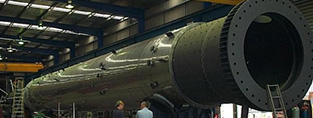
- (03) 5909 8218
- enquiry@fusionweld.com.au
How Do Debutanizer Columns Work?
July 14, 2017

Debutanizer columns (de-butaniser) are part of the fractional distillation family, but more on this family later. The target fraction, as the vessel descriptor implies, is butane. If you picture the natural gas stream entering the tall column, you can perhaps follow the fractionation process as it chemically separates the desired petroleum product. However, if process understanding should elude our non-engineering readers, we need to explain what's going on in this hydrocarbon soup, beginning with the input stream.
Humble Hydrocarbon Origins
As the natural gas flows into debutanizer columns, the NGL (Natural Gas Liquid) is boiled. High temperatures and pressure differentials process the evaporated organic compounds. This is a core part of the petroleum refinement process, with the various key organic compounds encountering similar fractionization configurations in their own monolithic separation columns. If our virtual camera were to pull back from the debutanizer column and pan, there's likely several other near identical structures installed in the same metal framework. This is the rest of the family, the ethane, propane, butane, and methane refinement vessels, and their job is to remove simple alkanes from the raw NGL stream.
A Debutanizer Primer
Push the focus forward again until the subject of our narrative is the only pressure vessel in our virtual frame. This is a fractionization tower that can reach as high as 60 metres tall, so it features as a dominant part of the refinery outline, as seen from great distances. The CH4 (Methane) component exists in the feedstock with the other alkane compounds, with the C4H10 (Butane) fraction only gaining its freedom when the vapourised gas condenses inside the array of valve trays that line the interior of the vessel. Obviously, then, this is no ordinary vessel, it's a sealed chamber that contains a wide assortment of precisely engineered valves and collectors. Based on thermal unit conversion technology, the boiling point of butane is used as a reference point here, an essential part of the distillation mechanism that will efficiently syphon butane from the raw NGL feed as long as the vessel's design maintains the process mandated temperatures and pressure.
Pure butane condenses in the debutanizer column when these variables are locked in by the architecture of the pressure vessel, so few impurities can form. Similarly, in the other alkane processing columns in this hydrocarbon refining frame, propane, ethane and methane are liberated and refined as valuable fuel sources. Again, though, the towering vessels must be built to an exacting standard if the thermal unit conversion system is to produce contaminant-free streams.
Contact Details
Fusion - Weld Engineering Pty Ltd
ABN 98 068 987619
1865 Frankston Flinders Road,
Hastings, VIC 3915
Ph: (03) 5909 8218
Optimized by NetwizardSEO.com.au
Recent Posts
- Heat Exchanger Maintenance in Melbourne: Minimising Risk in Power Generation Facilities
- Compressed Hydrogen Storage Vessels: Material Selection, Design & Australian Standards
- Welding QA/QC in Oil & Gas Pressure Vessel Fabrication – Ensuring Code Compliance
- AS1210 vs ASME VIII Pressure Vessel Code: Key Differences for Australian Projects
- Mitigating Hydrogen-Induced Cracking in Pressure Vessels: Engineering and Material Strategies
- Storage Tank Solutions Australia: Field-Erected, Prefabricated & Self-Bunded Explained
- Reducing Environmental Risks: Self-Bunded Tanks in Australian Oil & Gas Operations
- Precision in Production: How Pressure Vessels Are Manufactured for Industrial Safety
- Shell & Tube Heat Exchangers: Improve Thermal Control & Energy Recovery in Petrochemical & Pharmaceutical Plants
- In-Service Inspection for Compressed Air Receivers for Power Plant Shutdown Prevention
- Power Plant Pipe Spooling Fabrication – Get Rapid, Code-Compliant Spools Ready for Installation
- Field Erected Tanks: Safe, Reliable On-Site Fuel Storage Solutions in Australia
Posts 2026
- Heat Exchanger Maintenance in Melbourne: Minimising Risk in Power Generation Facilities
- View all articles…
Posts 2025
- Compressed Hydrogen Storage Vessels: Material Selection, Design & Australian Standards
- Welding QA/QC in Oil & Gas Pressure Vessel Fabrication – Ensuring Code Compliance
- View all articles…
Posts 2024
- Large Process Vessels: Optimising the Design for Maximum Efficiency [2025]
- Pressure Equipment Management System Installation: Detect Equipment Faults Early
- View all articles…
Posts 2023
- Pressure Piping System Inspection: A Gift of Safety for the Holidays
- Deaerator Inspections by Fusion-Weld Engineering and How They Reduce System Downtime
- View all articles…
Posts 2022
- How Fusion Weld Keeps Up With AS-NZS ISO 9001:2008 Standard
- Boiler Equipment Safety Inspection During the Summer Season
- View all articles…
Posts 2021
- Avoid These Factors and Practices that Contribute to Sealing Damage in Pressure Vessels
- Do's And Don'ts Of Industrial Boiler Inspection And Maintenance From Fusion-Weld
- View all articles…
Posts 2020
- What are the Risks and Hazards Involved in Pressure Vessel Equipment?
- How to Know if Your Pressure Equipment Needs Repair or Replacement?
- View all articles…
Posts 2019
- Factors that Contribute to Pressure Vessel Failure
- Pressure Vessel Regulations in Australia: What are the Mandatory Requirements?
- View all articles…
Posts 2018
- Pros and Cons of Spherical vs. Cylindrical Pressure Vessels
- What are the Different Hazard Levels in Pressure Vessels?
- View all articles…
Posts 2017
- Transportable Pressure Vessels: The Importance of Inspection and Safety Checks
- Fracture Mechanics and Stress Analysis of Cracks in Pressure Vessels
- View all articles…
Posts 2016
Posts 2015
- What Are Deaerators & Feedwater Vessels?
- Precautions and Safety for Compressed Air Receiver Vessels
- View all articles…
Posts 2014
- Demonstrating In-process Inspection Procedures
- Static Grounding Practices and Standards
- View all articles…